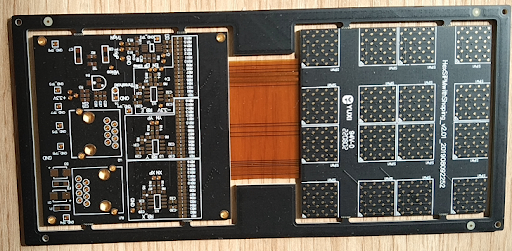When it comes to rigid-flex printed circuit board (PCB) design, various materials can be used to achieve the desired results. In this blog post, we’ll look at material considerations for rigid-flex PCB design and discuss some key considerations that need to be considered when making material choices.
Table of Contents
Choosing a Right Substrate Material
One of the most important considerations in rigid-flex PCB design is the choice of the substrate material. The substrate material forms the foundation of the PCB and needs to be carefully selected to ensure the board’s overall reliability and performance. There are a variety of different substrate materials that can be used for rigid-flex PCBs, but the most common choices are polyimide and FR-4.
Polyimide
Polyimide is a synthetic polymer with excellent mechanical and electrical properties. It is often used in applications where high temperatures are a concern, as it has a very high melting point. Polyimide is also very flexible, making it an ideal choice for flexible printed circuit boards.
However, polyimide is also one of the more expensive substrate materials and can be difficult to work with, so it is often reserved for more complex designs.
FR-4
FR-4 is a composite material made from glass fiber and epoxy resin. It is a very popular substrate material for rigid-flex PCBs due to its high mechanical strength and excellent electrical properties. FR-4 is also relatively easy to work with and is less expensive than polyimide, making it a good choice for simpler designs.
Selecting Dielectric Material
Once the substrate material has been selected, the next step is to choose the right dielectric material. The dielectric material is used to insulate the different layers of the PCB and needs to be carefully chosen to ensure optimal performance. Common choices for dielectric materials include polytetrafluoroethylene (PTFE) and polyimide.
Polytetrafluoroethylene (PTFE)
PTFE is a synthetic fluoropolymer that has excellent electrical insulation properties. It is often used in high-temperature applications due to its ability to maintain its properties at extreme temperatures. PTFE is also chemically resistant and has a low dielectric constant, making it an ideal choice for use in rigid-flex PCBs.
However, PTFE is a costly material and can be difficult to work with, so it is often reserved for more complex designs.
Polyimide
Polyimide is another synthetic polymer often used as a dielectric material in rigid-flex PCBs. Polyimide has excellent electrical and mechanical properties and can be used in high-temperature applications. However, polyimide is also a costly material and can be difficult to work with, so it is often reserved for more complex designs.
Picking Right Conductor Material
The next step in rigid-flex PCB design is to choose the right conductor material. The conductor material is used to connect the different parts of the PCB and must be carefully chosen to ensure optimal performance. Common choices for conductor materials include copper, aluminum, and gold.
Copper
Copper is the most common choice as a conductor material in rigid-flex PCBs. Copper is an easy-to-handle metal with significant electrical and thermal. But the downsides of copper include a higher cost and difficulty while soldering.
Aluminum
Aluminum is another common conductor material choice in rigid-flex PCBs. Aluminum has good electrical and thermal conductivity properties and is relatively easy to work with. However, aluminum is not as strong as copper and can be prone to corrosion.
Gold
Then we have Gold as the most expensive choice for use as a conductor material in rigid-flex PCBs. Gold is an excellent thermal and electrical conductor that is highly resistant to corrosion. However, gold is also very difficult to work with and can be difficult to solder, so it is often reserved for more complex designs.
Choosing Suitable Components
Once the substrate, dielectric, and conductor materials have been chosen, the next step is to choose the suitable component for your rigid-flex PCB. Components come in various shapes, sizes, and capabilities, so selecting the right one for your specific application is important. Common components for rigid-flex PCBs include resistors, capacitors, inductors, and transistors.
Resistors
They are available in a variety of different sizes and shapes, so they can be easily integrated into a rigid-flex PCB. The most common type of resistor is the carbon-film resistor, which is made from a carbon film deposited on a substrate. Carbon-film resistors are very inexpensive and are commonly used in low-power applications.
Capacitors
Capacitors store electrical charges and come in various shapes, sizes, and capabilities. The most common type of capacitor is the electrolytic capacitor, which uses an electrolyte solution to store electrical charge. Electrolytic capacitors are very inexpensive and are commonly used in low-power applications.
Inductors
For rigid-flex printed circuit boards (PCBs), surface mount inductors are the most common type used. The main reason is that they can be placed on both the board’s top and bottom sides, which helps save space. When choosing inductors for rigid-flex PCBs, it is essential to consider their current rating, inductance, Q value, and DC resistance.
Transistors
Transistors create electrical amplification in a circuit available in different shapes, sizes, and functionalities depending upon requirements. The most common type of transistor used in rigid-flex PCBs is the thin film transistor (TFT). TFTs are made by depositing a thin layer of semiconductor material onto a flexible substrate. They are firm and can withstand repeated bending and flexing without breaking.
Interconnect Selection
Once the substrate, dielectric, conductor, and component materials have been chosen, the next step is to choose the right interconnect for your rigid-flex PCB. Interconnects are used to connect the different parts of the PCB and come in a variety of shapes, sizes, and capabilities.
Solder Ball
The solder ball is the most common type of interconnect, made from a lead-tin alloy. Solder balls are very inexpensive and are commonly used in low-power applications.
Solder Bump
Another common type of interconnect is the solder bump, made from a lead-tin alloy. Solder bumps are more expensive than solder balls but have better electrical and thermal conductivity properties.
Wire Bond
The last type of interconnect is the wire bond, which is made from a gold or aluminum wire. Wire bonds are the most expensive type of interconnect, but they have the best electrical and thermal conductivity properties.
Also see: Rogers 4350B vs Megtron 6 vs Tachyon100G – High speed pcb Laminates Comparison Chart
Packaging of Rigid-Flex PCB
Once the interconnects have been chosen, the next step is to choose the proper packaging for your rigid-flex PCB. Packaging helps to protect the PCB from environmental hazards and provides mechanical support. The most common type of packaging for rigid-flex PCBs is the hermetically sealed package, made from a metal or glass material. Hermetically sealed packages are expensive, but they provide the best protection for the PCB.
Assembly Process
The last step in choosing the right materials for your rigid-flex PCB is to select the right assembly process. Assembly helps to connect all of the different parts of the PCB and can be done using a variety of methods, including soldering, bonding, and laminating:
- Soldering uses a lead-tin alloy to connect the different parts of the PCB
- Bonding is another type of assembly that uses an adhesive to connect the different parts of the PCB
- Laminating is the final type of assembly and uses a laminate material to connect the different layers of the PCB
Final Words
Rigid-flex PCBs are becoming increasingly popular because they offer many advantages over traditional PCB designs. By understanding the material considerations for rigid-flex PCB design, you can create both reliable and flexible boards. We hope this article helps you start your rigid-flex PCB design projects












